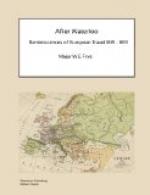Del biondo Dio che in Tessalia si adora.
I passed two hours in this cabinet. I next repaired to the centre of the city with the intention of ascending one at least of the two square towers or campanili which stand close together, one of which is strait, the other a leaning one. Garisendi is the name of the leaning tower, and it forms a parallelipipedon of 140 feet in height and about twenty feet in breath and length. It leans so much as to form an angle of seventy-five degrees with the ground on which it stands. The other tower, the strait one, is called Asinelli and is a parallelipipedon of 310 feet in height and about twenty-five feet in length and breadth. I ascended the leaning tower, but I found the fatigue so great that I was scarcely repaid by the fine view of the surrounding country, which presents on one side an immense plain covered with towns, villages and villas, and on the other the Appennines towering one above another. When on the top of Garisendi, Asinelli appears to be four times higher than its neighbour, and the bare aspect of its enormous height deterred me from even making the attempt of ascending it. When viewed or rather looked down upon from Garisendi, Bologna, from its being of an elliptical form and surrounded by a wall and from having these two enormous towers in the centre, resembles a boat with masts.
From the great celebrity of its University and the eminent men it has produced, Bologna is considered as the most litterary city of Italy. Galvani was born in Bologna and studied at this University, and among the modern prodigies is a young lady who is professor of Greek and who is by all accounts the most amiable Bas bleu that ever existed.[82] The Bolognese are a remarkably fine, intelligent and robust race of people, and are renowned for their republican spirit, and the energy with which they at all times resisted the encroachments of the Holy See. Bologna was at one time a Republic, and on their coins is the word Libertas. The Bolognese never liked the Papal government and were much exasperated at returning under the domination of the Holy Father. In the time of Napoleon, Bologna formed part of the Regno d’ltalia and partook of all its advantages. Napoleon is much regretted by them; and so impatiently did the inhabitants bear the change, on the dismemberment of the kingdom of Italy, and their transfer to the pontifical sceptre, that on Murat’s entry in their city in 1815 the students and other young men of the town flew to arms and in a few hours organised three battalions. Had the other cities shown equal energy and republican spirit, the revolution would have been completed and Italy free; but the fact is that the Italians in general, tho’ discontented, had no very high opinion of Murat’s talents as a political character, and he besides committed a great fault in not entering Rome on his march and revolutionising it. Murat, like most men, was




